Renault Laguna Coupe GT 3.0D V6 Review
Renault Laguna Coupe GT 3.0D V6
Riyad takes a look at all the technology that Renault has squeezed into its new coupe.
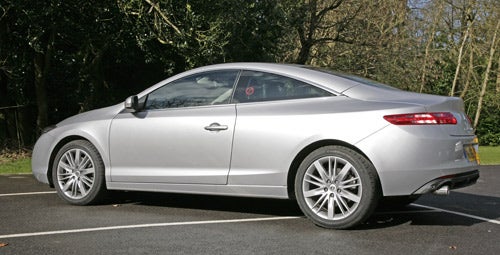
Verdict
The coupe is a strange beast. Despite the fact that coupes are often based on more mundane saloon models, these cars are all about emotion rather than practicality. The coupe may represent style over substance to some, but there are many that would rather have a smile on their face than a bit more luggage and rear seat space. I’ve got to say that I fall into the former group, and even though I have a young daughter and another child on the way, neither of my cars have four doors. I’m not saying that practicality isn’t important to me, it’s just not ”that” important to me.
The Renault Laguna Coupe definitely looks the part – this is a very handsome car that gets more than its fair share of admiring glances from other motorists and passers by. Many in the TrustedReviews office commented that the rear quarter (arguably its best angle) was reminiscent of an Aston Martin, and you can’t get much more of a compliment than that! In profile this car is every inch a coupe, with smooth, flowing lines and a shape that looks as though it will glide through the air. The front-on angle isn’t quite as successful, but it’s by no means ugly.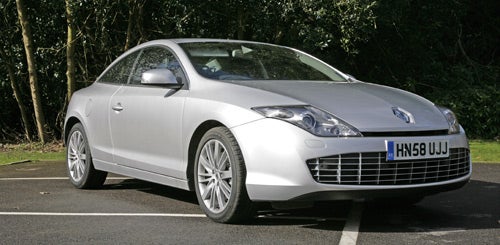
Renault offers two basic versions of this car, the Coupe and the Coupe GT, with the latter offering a plethora of extra bells and whistles as standard. There’s also a range of engines on offer from a 2.0l turbo petrol lump all the way to a 3.0l V6 diesel option. There’s also a 3.5l V6 petrol engine, but this falls into the higher road tax band, which will cost you a whopping £400 per year! Considering that the V6 diesel pumps out only 5bhp less than the 3.5l petrol engine, turns in far superior fuel consumption and will cost only £210 a year to tax, it’s clear which V6 option makes the most sense. 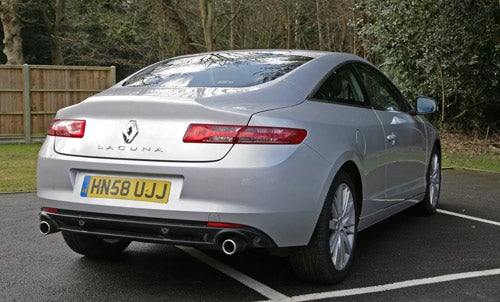
Renault is clearly aware of the compelling argument for diesel power and supplied me with a 3.0l V6 diesel car, stacked to the gills with every technological gizmo from the options list. And of course it’s all the technology that Renault has squeezed into the Laguna Coupe that’s of real interest here at TrustedReviews. So, is the Laguna Coupe as clever on the inside as it is stylish on the outside? There’s only one way to find out.
My Laguna Coupe test car came equipped with Renault’s top of the range sat-nav and entertainment system. I’ll cover the satellite navigation a bit later, but for now let’s look at the entertainment side.
The in-car entertainment comes courtesy of Bose, which gave me cause to worry initially. Back in 2000 I bought an Audi TT and specified the Bose hi-fi, only to be woefully disappointed by it. Last year when I was speccing a new car and the salesman asked me if I wanted the Bose system I adamantly refused.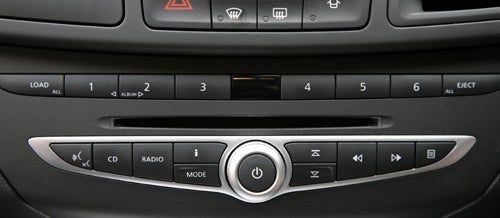
I was, however, somewhat surprised when I fired up the Bose system in the Laguna, because it doesn’t sound bad at all. The sound stage is quite expansive, and the music fills the whole car in an omnidirectional manner that few in-car systems can manage. It’s not quite in the same league as the Dolby Surround certified Alpine system that I tested a couple of years ago, but it’s good nonetheless.
The Bose hi-fi produces good detail in the mid range, and although it’s slightly lacking in the bass department, this isn’t the type of car where the driver is likely to be rattling the windows with the volume turned up to max. 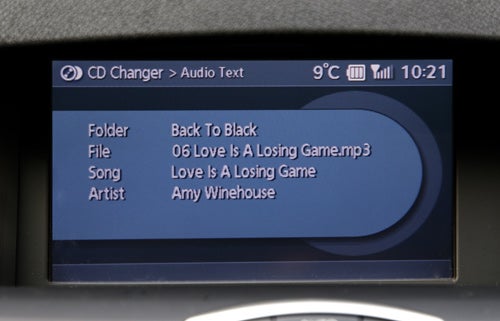
There’s a six CD changer built into the dash, so there’s no need to dig around in the boot every time you want to change your music. It’s also good to see that as well as standard audio CDs, this system will happily read MP3 and WMA files. This potentially allows you to carry a huge library of music in the car with you at all times. And that’s a good thing too, because if you were hoping to hook your iPod (or any other portable player for that matter) up to the Laguna, you’ll be sorely disappointed.
Although Renault claims that this car has an “MP3 connection point”, what that actually means is that there are a couple of analogue RCA jacks in the centre console storage box. So, not only will you need a 3.5mm mini-jack to stereo phono cable, you won’t be able to control your player using the in-car controls, and something as simple as changing track will require you to physically pick up your player and use its controls. At least Renault has been thoughtful enough to put a 12V output in the box too, so you can charge your player while you’re using it. 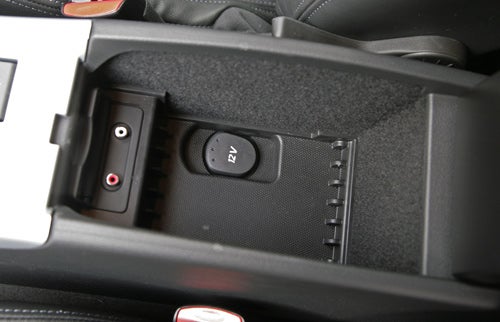 ”’(centre)Twin RCA jacks are not my idea of MP3 player connectivity(/centre)”’
”’(centre)Twin RCA jacks are not my idea of MP3 player connectivity(/centre)”’
Considering that proper in-car iPod and USB connectivity is becoming pretty ubiquitous these days, it seems strange that Renault has equipped its most modern and stylish car with such an outdated interface. Thankfully the documentation that Renault supplied with the car states that the Laguna Coupe will be available with the TunePoint system soon, which adds USB connectivity and the ability to control your player via the in-car system. It’s shame that I didn’t get to test TunePoint, but if you’re keen iPod user, it’s an option that may well be worth waiting for. 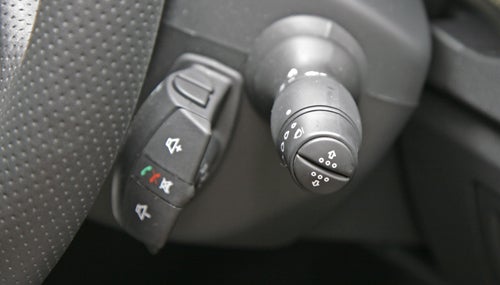
All the controls for the stereo are well laid out in the central dash, making it easy to switch between tracks, folders or even CDs. You also get audio controls mounted on the right side of the steering column, which allow you to adjust volume, switch between CD and Radio sources, and of course change tracks. Rather than having buttons to skip forward or backwards between tracks, Renault has equipped its remote audio controls with a jog dial. I’m sure that this seemed like a good idea at inception, but I find the jog dial quite frustrating on my Clio 197 F1 and often end up jumping several tracks instead of one. However, the jog dial on the Laguna Coupe is smaller than the one on my Clio, making it far easier to skip one track at a time.
Although Bluetooth connectivity has become pretty much ubiquitous in our lives, it still surprises me that cars are available without the option of wireless hands-free. Unsurprisingly, Renault hasn’t made that mistake with the Laguna Coupe, and the test car came equipped with full Bluetooth connectivity and voice control.
It’s testament to the car’s logically laid out menus that I was able to pair my phone with the Laguna in a matter of minutes, without the need to refer to any documentation. Once paired, your phone will automatically connect whenever you start the car (assuming that you have it with you of course). Once connected, the Laguna’s information screen will display how much battery your phone has, and the current signal strength. The latter is particularly useful, allowing you to ascertain whether you have a strong enough signal to make a call before attempting to do so. 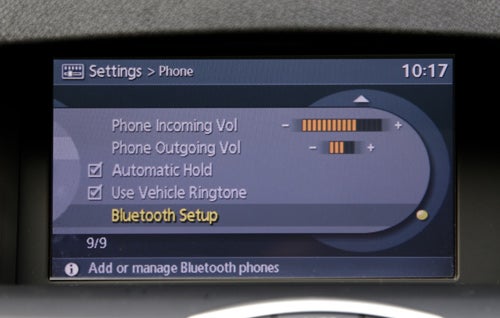
As with all Bluetooth hands-free systems, call quality is as much to do with your phone as it is to do with the system. That said, the audio quality in the car was exceptionally good, while at the other end I was assured that my voice came through loud and clear. A nice touch is that when you answer a call while driving, the caller receives an automated message informing them that you’re driving. You can choose to leave them holding until you pull over, or carry on driving while you chat.
The voice recognition is also phenomenally good. OK, so I still think that voice control of stereo functions is something of a gimmick, but for voice dialling, and even basic sat-nav commands, it can be a real benefit. You can copy your entire contact list from your phone across to the Laguna via Bluetooth. You can then scroll through the contacts list or, for ultimate convenience, assign voice tags to each entry. Once I’d recorded voice tags, the system recognised my requests perfectly without fail, whether driving or stationary.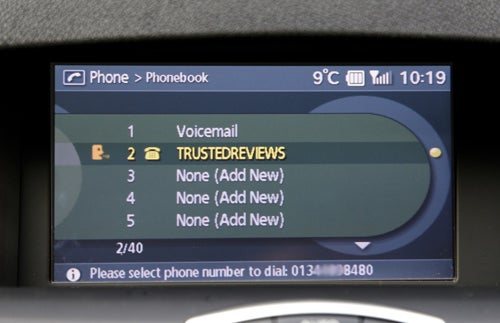
Of course when you’re dialling people in your contacts list, the system is comparing your voice command to the voice tag you recorded, it’s still impressive that it always gets it right. More impressive is that the system managed to correctly recognise commands that weren’t simple comparisons to my own inputs. If I chose to dial a phone number manually, the system managed to get it right every time. I wasn’t saying each digit slowly and letting the Laguna recognise it before moving onto the next one either. I’m talking about blurting out an 11 digit number in one go and the system getting it spot on each and every time!
There’s a voice command button nestled in the steering column audio controls, so it’s very simple to initiate voice control. As soon as the button is pressed your music is muted and the system will instruct you to give a command after the beep. If you change your mind you can say “cancel” or simply press the voice command button again.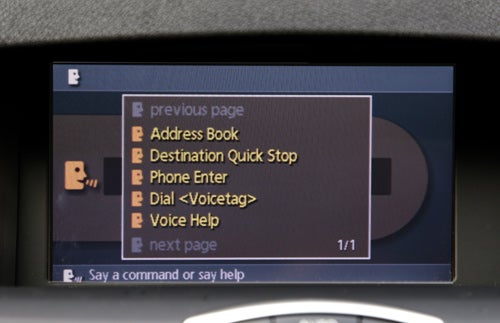
It’s also worth noting that multiple phones can be paired with the car, which is useful for situations where multiple people drive a vehicle. In this instance the contacts list associated with each phone is only accessible when that specific handset is detected and connected, so no one will be able to rifle through your phone numbers when you’re not in the car.
One last Bluetooth goody comes in the form of A2DP support. This means that if your phone or MP3 player is also A2DP compliant, you can stream your music wirelessly to the in-car stereo system. Of course you still won’t be able to control the music using the car’s controls, but it does mean that you can whack out your favourite playlist without needing to take your phone out of your pocket – well, except to press play, but that’s it!
The top of the range in-car technology package (£2,200 worth) also incorporates Renault’s 3D satellite navigation system. The heart of the sat-nav system is a 7in 16:9 screen that’s mounted quite deep in the dash. The recessed position of the screen means that it’s easy to view no matter what the ambient lighting conditions – even with bright sunlight streaming through the windows I had no problem viewing the screen from the driver’s seat. 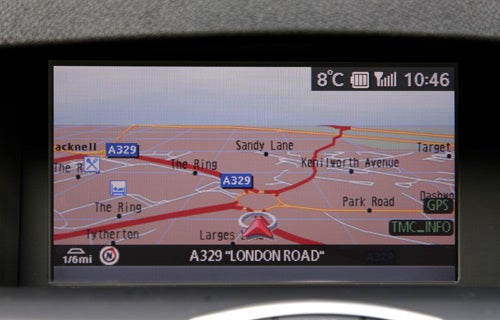
In-car sat-nav systems are often criticised for being expensive and under featured compared to good after market devices, so let me get the bad news out of the way first. Unfortunately the sat-nav in the Laguna Coupe suffers from a couple of major issues that really shouldn’t be there considering that this is a very new car. First up, there is no postcode support. Now, I’m used to finding limited, five digit postcode search facilities on in-car navigation systems, in fact one of my own cars suffers from this, but to have no postcode search at all is very disappointing.
The real downside of not having postcode support is that you need to know the full address of your destination, including house number in order to be taken there directly. This isn’t always easy, especially when you’re trying to navigate to a business address. The TrustedReviews office for example is on a very long road and has no house number associated with it, so you really need postcode location to find it.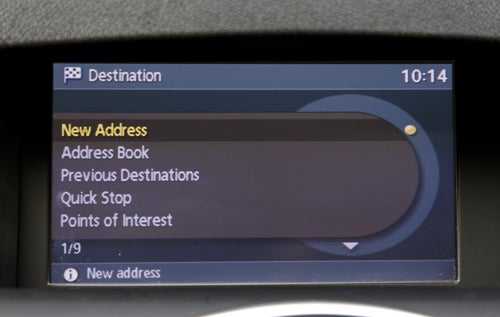
The second disappointment is that in a car as new as the Laguna Coupe I would have liked to have seen a touch-screen system. That said, I’m willing to forgive Renault for this one, since the position of the screen doesn’t make a touch-screen solution ideal, and moving the screen elsewhere would make it more difficult to view at a glance. There is however, no doubt that a touch-screen interface would make entering data far easier.
The controls for the satellite navigation, and most other things for that matter, are located in the centre console. Here you’ll find a rotating dial surrounded by buttons. Obviously the dial can scroll through menus, but it’s also a four-way joystick, so navigating through menus and screens is pretty simple. As you’d expect, pressing the dial inward selects the current option/letter/number. Entering a destination address isn’t too difficult, since you can quickly breeze through the alphabet horizontally by twisting the dial, and jump between rows by pressing the joystick up or down. 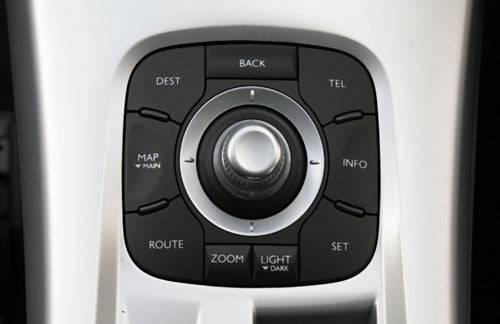
Once you’ve got your destination configured, the sat-nav does a pretty good job of getting you were you need to go. Instructions are clear and reasonably concise, and you’re given a decent amount of warning before turns. The 3D map display looks good, and will automatically switch to a night-time version once the sun has gone down to avoid unduly distracting you while you’re driving. 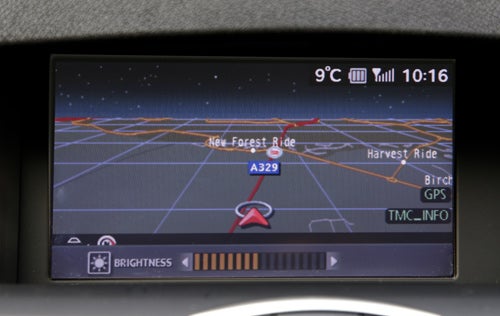
The map display can get crowded if you’ve got points of interest turned on though. When I drove the car into the West End of London, the map was stuffed so full of bars, restaurants, petrol stations and coffee shops, that it was almost impossible to see what roads were being displayed. 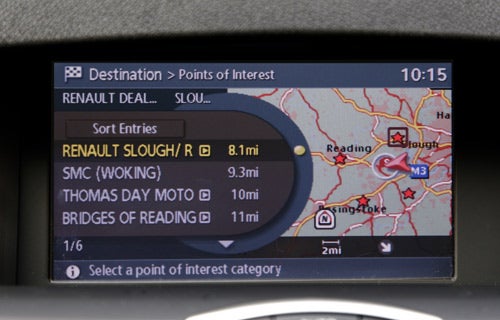
While I’m on the subject of Points of Interest, I should mention that the database isn’t particularly up to date. OK, I know that it’s almost impossible for any sat-nav manufacturer to keep on top of which coffee shops or restaurants are still in business, especially in this climate, but there are certain Points of Interest that I would expect to be current. One of the things you can search for is Renault dealers close to you, and when I searched for dealers near me, two out of the four listed on the first page had closed down. To be fair, one of them had only closed a couple of weeks ago, but the other went out of business last summer!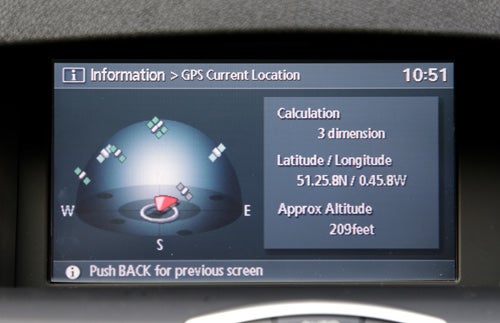
You can customise your route once it has been calculated, adding waypoints along the way if you so choose. Routes can also be updated based on TMC data, in order to avoid traffic jams or accidents as they get reported. You can also interrogate the TMC database before setting off to see where the traffic black spots are in advance. 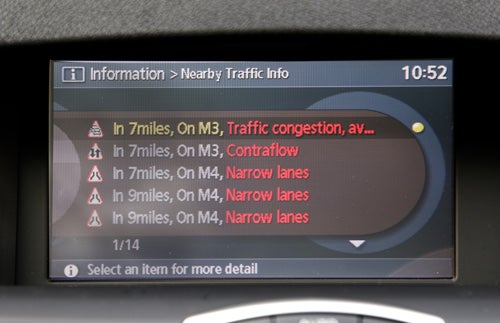
Renault has recently announced that it is continuing to work with TomTom to provide in-car sat-nav solutions in a number of models, so I can only hope that this collaboration will spawn some integrated systems with all the features that TomTom’s high end after market devices sport. If that turns out to be the case, I’ll be testing one as soon as they’re available.
If the prime factor for any Coupe is to look good, the second most important point is that it needs to be comfortable. The GT spec Laguna Coupe comes with full leather interior as standard, and the test car also included electrically adjustable seats. You also get heated seats, although it took me a while to find the controls.
When I first got into the car the heated seat was switched on and no amount of scanning the centre console or dash revealed a switch to turn it off. I eventually noticed the switch the next time I climbed into the car – it’s actually on the seat base, near the adjustment buttons. Not a bad position – once you know it’s there of course.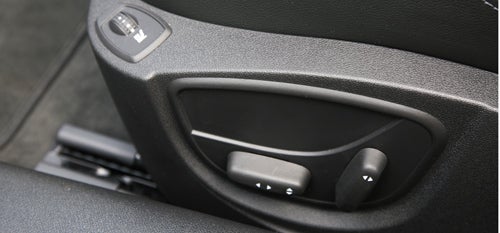 ”’(centre)Finding the heated seat control isn’t easy at first, but once you know it’s there, it’s not a problem(/centre)”’
”’(centre)Finding the heated seat control isn’t easy at first, but once you know it’s there, it’s not a problem(/centre)”’
If you do a lot of motorway miles, you’ll be glad of the cruise control and speed limiter features, especially in these times of over zealous ‘safety’ cameras. The switches for cruise control and the speed limiter are on the centre console next to the parking brake. The limits can then be set using buttons built into the steering wheel – which, incidentally is one of the best I’ve ever held.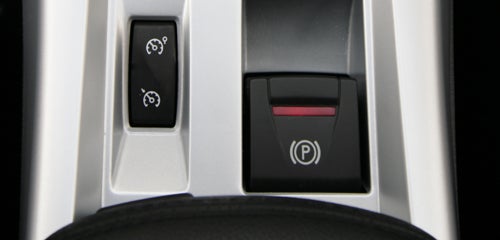 ”’(centre)The cruise control and speed limiter switch is located to the left of the parking brake(/centre)”’
”’(centre)The cruise control and speed limiter switch is located to the left of the parking brake(/centre)”’
On the subject of the steering wheel; Renault has made sure that the amount of turning is kept to a minimum thanks to the implementation of four-wheel steering. The 4Control system comes as standard on the GT spec Laguna Coupes, and brings with it a combination of low speed manoeuvrability and high speed stability. The basic premise is that at lower speeds the rear wheels turn the opposite direction to the front wheels, allowing the car to pivot and reduce the turning circle. At higher speeds though, the rear wheels turn in the same direction as the front wheels, aiding stability through the bends. Four-wheel steering has been around for a while, but it’s still good to see it implemented, especially on a relatively long car.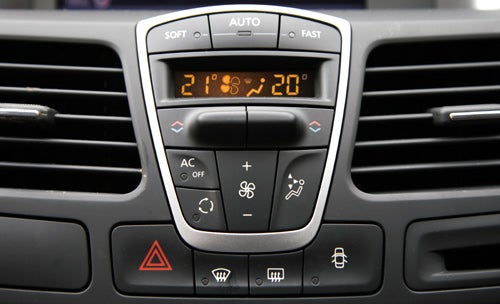
As well as seat heating, the Laguna Coupe also gets dual zone climate control, which allows the driver and passenger to set different temperatures. This is nothing new, but it’s one of those incredibly useful features, especially if your partner gets cold really easily and you get hot too quickly – as is the case with myself and my wife. The controls are mounted in the centre dash, with simple dual temperature displays, and an up/down switch to make adjustments.
Continuing to make the driver’s life easier are automatic Xenon headlights, automatic windscreen wipers and an auto-dimming rear view mirror. Pretty much everything you’d expect from an executive coupe in fact, but no less welcome. The auto-dimming rear view mirror is one option box that I always make sure I tick when speccing up a new car.
Renault takes occupant safety very seriously, and even the humble Clio has a five star NCAP rating. It therefore comes as no surprise that the Laguna Coupe also achieved the full five stars, scoring 36 out of a maximum 37 points for occupant safety.
There are eight airbags positioned around the cabin to ensure that passengers are protected no matter what the angle of impact. In the case of a head-on collision, there are two dual-volume airbags that will deploy with differing degrees of form and volume depending on where the driver’s seat is positioned. 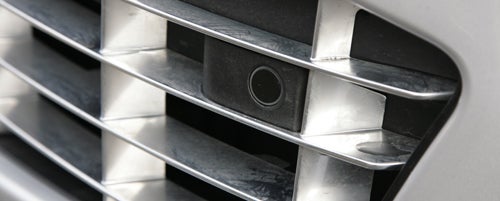 ”’(centre)Rear parking sensors are standard, but the sensors mounted in the front grille are a £300 option(/centre)”’
”’(centre)Rear parking sensors are standard, but the sensors mounted in the front grille are a £300 option(/centre)”’
Both rear seats feature ISOFIX anchoring points, so even if you have a couple of kids you shouldn’t have trouble fitting them in. It’s also surprisingly spacious for children in the rear – my three year old daughter was very comfortable for well over an hour, although she did fall asleep for much of that time.
The Laguna Coupe also features key-free entry and start, and if you haven’t used such a system, you really don’t know what you’re missing. My Clio 197 uses the same system, and it really does make life so much easier.
The flat key-card sports all the buttons you’d expect to see – lock, unlock, boot release and even a button to turn the lights on – but you shouldn’t really need to use any of them. The idea is that you keep the key-card in your pocket, and as long as you have it with you when you attempt to open the door, the car will unlock. Once inside, it’s just a case of putting your foot on the brake and pressing the Start/Stop button to fire up the engine. ”’(centre)A lock button is missing from the passenger door handle, but the car will lock itself as soon as you walk away(/centre)”’
”’(centre)A lock button is missing from the passenger door handle, but the car will lock itself as soon as you walk away(/centre)”’
There’s also a button on the door handle which will lock the car, although I was surprised to find that only the driver’s door handle was equipped with a lock button. This meant that when I took my daughter out of the passenger side of the car I then had to walk around to the driver’s side to lock it. That was until I realised that the Laguna will lock itself as soon as it detects you walking away with the key-card in your pocket!
You also don’t have to worry about remembering to put the handbrake on, because this car doesn’t have one. Renault has equipped the Laguna Coupe with an electronic parking brake, which can be engaged or disengaged at the touch of a button in the centre console. 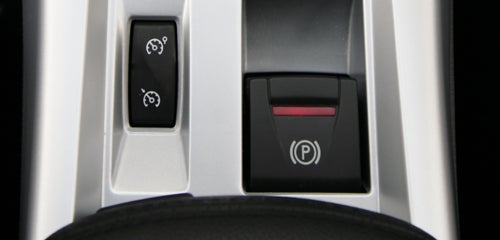 ”’(centre)The electronic parking brake will automatically engage and disengage, but you can also apply it manually(/centre)”’
”’(centre)The electronic parking brake will automatically engage and disengage, but you can also apply it manually(/centre)”’
However, you don’t even need to remember to engage or disengage the parking brake. When you put the car into Drive or Reverse and touch the accelerator, the parking brake automatically disengages. Likewise, when you put the car into Park and switch the engine off, the parking brake automatically engages.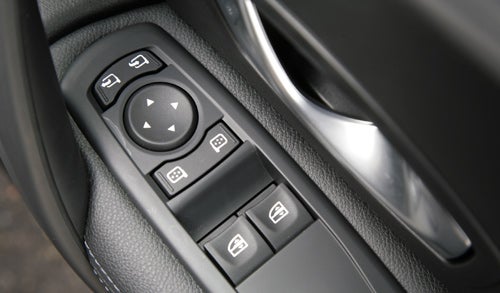
The test car also came with electrically folding mirrors, and front and rear parking sensors. The sensors provide audible indication of how close you are to obstacles, but there’s no visual indication of distance. The audible alerts are also pretty generous, so even when the beeps become solid, there’s still a reasonable amount of space.
Of course there’s also a Thatcham Category 1 alarm and engine immobiliser as standard, all of which works in conjunction with the key-free system.
Renault has done a far better job of creating a modern coupe than I had expected. Any coupe or GT car needs to look great, be comfortable and make the driver feel like he’s sitting somewhere special. On all those counts the Laguna Coupe scores pretty highly. The fact that this is the only Laguna Coupe I’ve ever seen also brings with it a level of exclusivity, that simply can’t be associated with the ubiquitous BMW 3 Series Coupe. Of course there’s a reason that you see a lot of BMW 3 Series Coupes – they’re very good cars, and carry with them a certain degree of brand cache along with the dynamic advantage of a rear wheel drive layout. I would, however, argue that the Laguna makes a more handsome coupe than a 3 Series – yes that’s a completely subjective opinion, but then part of the car buying process is emotional, and always will be.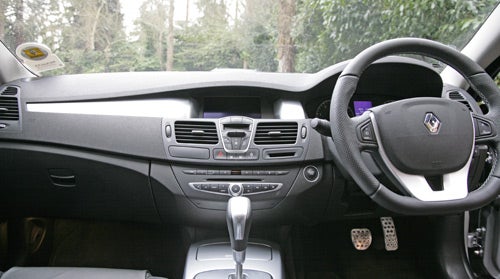
What isn’t emotional or subjective is the quality of the equipment that you’ll find inside a new car, and here Renault has produced a mixed bag. There’s no denying that the main infotainment system has some great features, with the Voice Control in particular proving to be the best I have ever experienced. However, the lack of touch screen and more importantly, postcode input on the sat-nav is very disappointing by modern standards.
Renault’s keyless entry and start system may have been around for a while, but it remains a very useful feature that you wouldn’t want to be without once you’ve tried it. Also the implementation of four-wheel steering makes this an easier car to manoeuvre than you’d think.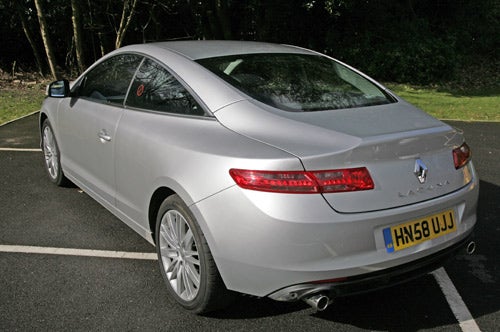
Ultimately, the Laguna Coupe has all the ingredients of a good cruising GT car, and even after a long drive you’ll probably step out feeling fresh and relaxed. But this car doesn’t come cheap, and in this specification with all the tech-toys that we’ve talked about here will set you back over £30k. That said, a similarly specced BMW 330D (which has about 10bhp more power) will set you back well over £40k. Whether that makes a fully loaded Laguna Coupe a bargain is still debatable, but if you’re looking for something a bit different, it could be an attractive alternative.

